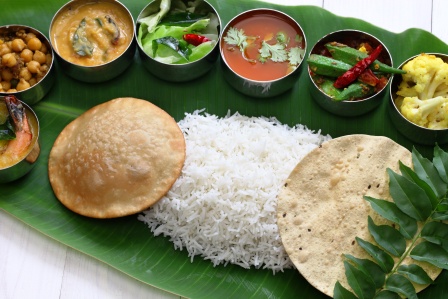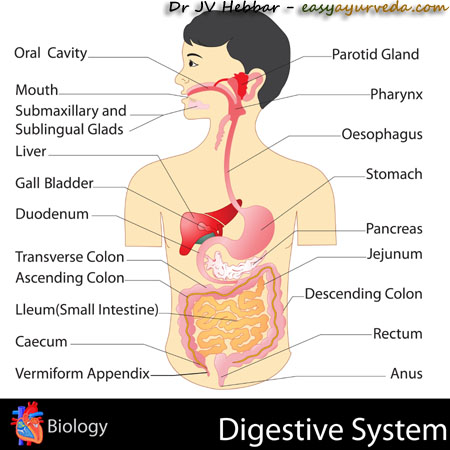Normal Dosha Vitiation In Relation To Digestion
Article by Dr Raghuram Y.S. MD (Ay) & Dr Manasa, B.A.M.S
Table of Contents
Introduction
Dosha Dushti means dosha vitiation. Dosha vitiation causes diseases. This dosha vitiation may be either prakrita (normal) or vaikruta (abnormal).
Prakrita Dosha Dushti is a temporary vitiation for a short period. If this is neglected or when particular Dosha increasing causes are consumed, continuously, the normal dosha vitiation may lead to vaikrita dosha dushti. This,in due course of time will go through various pathological stages (kriya kala) and causes samprapti (pathogenesis) of a disease.
Doshas get vitiated even during different phases of digestion, which will generally be a normal type of vitiation.
Relation to stages of digestion
Prakrita Dosha Dushti (Normal Dosha Vitiation) during different stages of digestion of food
Just like the normal dosha dushti occurring during the seasonal and diurnal changes, the doshas tend to naturally get increased or vitiated during different stages or phases of digestion.
Related Reading – Normal Vitiation of Doshas As Per Seasonal Variation
During these phases of digestion, doshas are formed and nourished. Doshas enriched in their places also support their subtypes located in other places of body.
Read – Types Of Doshas And Their Functions
Each dosha will get increased during a different phase of digestion of food. The vitiated dosha or the dosha which had undergone a temporary dushti or vitiation will normally settle down to normalcy during the upcoming anna kala or phase of digestion. Such vitiation of dosha in a particular anna kala or phase of digestion is considered as prakrita dushti of that particular dosha.
Related Reading – Natural Dosha Increase During Day And Night

Let us understand this with suitable examples –
Digestion of food in Ayurveda is divided into three phases.
Ama Avastha
This forms the first phase of digestion wherein the food is partially digested in the stomach after consuming it. At the end of this phase ama or intermediate products of digestion are formed. Therefore it is called Ama Avastha.
Formation of Kapha
This stage of digestion supports kapha and hence there is increase in kapha during this stage. The food acquires sweetness and is therefore called as Madhura Avastha Paka. Therefore the beginning couple of hours of digestion process belong to the activity of kapha and hence it is found in more proportions. The increased kapha spontaneously gets settled down to normal proportions once the Pachyamana Avastha begins. This happens as a rule and is quite normal for kapha and hence is prakrita kapha dushti.
Pachyamana Avastha
Pachyamana or Jeeryamana Avastha – This is the second phase of digestion wherein the food is in the process of getting digested. The food from the ama stage is propelled into the small intestines wherein the digestion of food is continued until completed. At the end of this stage, achcha pitta or pure form of pitta is formed.
Formation of pitta
This stage of digestion supports pitta and hence pitta is increased in this stage. The food acquires sour taste in this stage and hence this stage is called Amla Avastha Paka. Therefore the duration while the digestion is actively taking place belongs to the activity of pitta and hence it is found in high proportions during this stage. The increased pitta settles down to normal proportions once the Pakva Avastha sets in. This happens as a rule and is quite normal for pitta and hence is prakrita pitta dushti.
Pakva Avashta
Pakva or Jeerna Avastha – This is the third and final phase of digestion of food wherein the absorption of water and nutrients take place in the large intestine. The food which has been completely digested in the Pachyamana stage is sent into the large intestine wherein the ingredients necessary for the body are reabsorbed and the formation of feces and flatus takes place. Paripindita purisha or formed stools are formed which get prepared to be expelled in due course of time.
Formation of vata

Vayu is formed at the end of the process. The ingredients acquire pungent taste in this stage and hence this stage is called Katu Avastha paka. Therefore this phase wherein the final processing of products of digestion takes place and the feces are getting ready to be expelled belongs to the activity of Vata and hence vata is found in high levels in this stage. The increased Vata settles down once the process is completed and after the expulsion (excretion) of feces and flatus. This happens as a rule and is quite normal for vata and hence is prakrita vata dushti.
Since the temporary increase of each dosha takes place in its related time of digestion,
i.e. kapha in ama stage,
pitta in pachyamana stage and
vata in pakva stage
and those increased doshas get settled down to normal proportions at the end of their related stage of digestion, they are considered as normal (and temporary) dosha vitiation in relation to food.
Importance
Importance of having the knowledge of dosha dushti during phases of digestion
It is always good and important to discriminate between what is normal and what is abnormal, especially for a doctor. Dosha dushti taking place during different phases of digestion of food as discussed above is a natural process and the physician should know this. It is important because he needs to transfer this knowledge to his clients seeking medical advices and remedies for digestive problems. He needs to tell the patients if the doshic symptoms which are flaring up in them are normal or abnormal.
Read related: Role of Doshas In the Causation of Disease
If the doshic symptoms are increased constantly and troubles the patient consistently and when they do not settle down during the next phase of digestion, the physician looks at it as an abnormal condition of doshas probably reflecting the possible onset (in future) or already existing digestive tract ailment. This helps in planning the treatment and dietetic corrections for the patients.
But when there is prakrita dushti he can tell them that the doshas are behaving normal and that there is absolutely nothing to worry. We do not treat normal dosha vitiations because they settle down on their own. A small discipline and some adjustments are needed in relation to diurnal and seasonal regimens and also slight adjustments in the form and nature of food and timing of food to help the doshas to settle down.
Organs related to Avastha paka
A note on seats and organs related to avastha paka in relation to modern anatomy and physiology
The sweet phase of digestion is said to take place in stomach and sour phase of digestion to take place in small intestine. Last part of digestion i. e. pungent phase is said to take place in large intestine. But when we look at modern anatomy and physiology, large colon is not a digestive organ. No digestion of food takes place in colon. It is only that residue water, minerals and salts are absorbed into colon. Later feces is formed and excreted.
The term pakwashaya mentioned in context of pungent phase of digestion is large intestine going with ayurvedic translation. Ayurveda also has said solidification of digested food which can be nothing but feces. Pungent taste and environment produced can be compared to gases and fart which is produced due to chemical process and action of bacterial flora on food in colon. This justifies colon as place of pungent phase of digestion.
If avastha paka means stage wise digestion of food, colon cannot be considered in strict terms. This is because no digestion takes place in colon.
Therefore taking into consideration digestive zones of alimentary tract, and also considering ayurvedic term paka as digestion, many scholars of ayurveda conclude that –
- Sweet phase of digestion takes place in upper part of stomach
- Sour phase of digestion takes place in lower part of stomach and first part of small intestine i. e. duodenum
- Pungent phase of digestion takes place in lower part of small intestine i. e. jejunum and ileum
Three phases of digestion
Alternatively three phases of digestion can be understood as –
- First phase begins in mouth and completes in upper stomach. First half of food stay in stomach, getting prepared for first part of digestion, getting mixed with mucus and being converted into a bolus can be considered.
- Second phase begins in lower part of stomach and later part of stay of food in stomach wherein it is partially digested; being acted upon by acids can be considered. This phase also continues in duodenum wherein food mixed with acids propelled from lower stomach is acted upon by digestive enzymes including bile, pancreatic juice etc.
- Third and last phase of digestion begins in second part of small intestine i. e. jejunum and ends in large colon. Absorption of essence of digested food takes place in small intestine and absorption of residue water, salts and minerals take place in colon with solidification of waste products and formation of feces and flatus.
Effect of Vipaka on doshas
Vipaka or nishta paka means post digestion change in taste. Read –Vipaka: Taste Conversion During And After Digestion
When substances we consume, especially medicinal herbs, come into contact with digestive fire and gets digested by it, they undergo change in their tastes. This post digestion change in taste of a substance is called vipaka.
- Substances of sweet and salt tastes get converted into sweet after-taste. This is called madhura vipaka. This will increase kapha.
- Substances of sour taste get converted into sour after-taste. This is called amla vipaka. This will increase pitta.
- Substances of pungent, bitter and astringent tastes get converted into pungent after-taste. This is called katu vipaka. This will increase vata.
Thus, after-tastes will have a similar impact on doshas as in 3 phases of digestion.
Click to Consult Dr Raghuram Y.S. MD (Ayu) – Email / Skype










